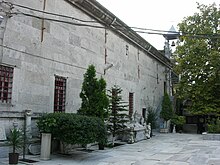Church of St. Mary of the Spring (Istanbul)
| Church of St. Mary of the Spring | |
|---|---|
| Ζωοδόχος Πηγή | |

The modern church viewed from north
|
|
| 41°00′24″N 28°54′57″E / 41.0066°N 28.9158°ECoordinates: 41°00′24″N 28°54′57″E / 41.0066°N 28.9158°E | |
| Location | Balikli, Istanbul |
| Country | Turkey |
| Denomination | Greek Orthodox |
| History | |
| Founded | 559-560 |
| Founder(s) | Justinian |
| Dedication | Theotokos Pegè |
| Cult(s) present | Saint Mary |
| Architecture | |
| Completed | 1835 |
The Monastery of the Mother of God at the Spring (full name in Greek: Μονὴ τῆς Θεοτòκου τῆς Πηγῆς, pr. Moni tis Theotóku tis Pigis; Turkish name: Balıklı Meryem Ana Rum Manastiri) or simply Zoödochos Pege (Greek: Ζωοδόχος Πηγή, "Life-giving Spring") is an Eastern Orthodox sanctuary in Istanbul, Turkey. The present church, built in 1835, bears the same dedication as the shrine erected in this place between the end of the fifth and the beginning of the sixth century. After several renovations, this building was destroyed in the first half of the fifteenth century by the Ottomans. The complex got its name from a nearby holy spring, reputed to have healing properties. For almost fifteen hundred years, this sanctuary has been one of the most important pilgrimage sites of Greek Orthodoxy.
The church is located in Istanbul, in the district of Zeytinburnu, in the neighbourhood of Balıklı, along Balıklı Sivrikapı Sokak. It lies a few hundred meters outside the walled city, about five hundred meters from the Gate of Silivri (Turkish: Silivri Kapısı). The complex is protected by a high wall, and – being surrounded by Eastern Orthodox and Armenian cemeteries – lies in a green landscape.
According to historians Procopius and Cedrenus, the church was originally erected by Emperor Justinian in the last years of his reign (559-560) near a fountain of water from a holy well (Greek: ἁγίασμα, hagiasma, whence Turkish: ayazma) situated outside the walls of Theodosius II in correspondence of today's Gate of Silivri. During hunting the Emperor noticed a small chapel surrounded by many women. Asking the meaning of the building, he was told that this was the “source of the miracles”. He at once ordered that a magnificent church be built there, with the material remaining after the erection of the Hagia Sophia.
...
Wikipedia

